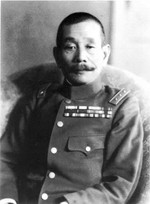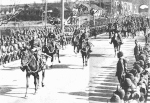Iwane Matsui
| Surname | Matsui |
| Given Name | Iwane |
| Born | 27 Jul 1878 |
| Died | 23 Dec 1948 |
| Country | Japan |
| Category | Military-Ground |
| Gender | Male |
Contributor: C. Peter Chen
ww2dbaseIwane Matsui was born as the sixth son of a former samurai retainer of the Tokugawa Clan of the Owari Domain. He graduated from a military academy in May 1896, and comleted studies at the Japanese Army Academy in Nov 1897. In Jun 1898, he was promoted to the rank of lieutenant. In Nov 1900, he was promoted to the rank of 1st lieutenant. Between 1904 and 1905, he participated in the Russo-Japanese War of 1904 to 1905, seeing action in northeastern China. In Aug 1904, he was promoted to the rank of captain. In Nov 1906, he graduated from the Army Staff College at the top of the class. Between Jan 1907 and Apr 1911, he served in Beijing and Shanghai in China; during that time, in Nov 1909, he was promoted to the rank of major. In 1913 and in 1914, he visited French Indochina and Europe as a representative of the Japanese Army. In Aug 1918, he was promoted to the rank of lieutenant colonel and was attached to the 22nd Infantry Regiment. Between Dec 1915 and Feb 1919, he served in Shanghai, China. In Jul 1918, he was promoted to the rank of colonel. Between 1919 and 1921, he was the commanding officer of the 29th Regiment. Between 1921 and 1922, he was attached to the staff of the Vladivostok Expeditionary Force, which fought against Bolshevik Red Army forces in eastern Russia. Between 1922 and 1924, he served in northeastern China as the head of the Harbin Special Services Agency, an intelligence unit. In 1923, he was promoted to the rank of major general. Between 1924 and 1925, he was the commanding officer of the 35th Infantry Brigade. Between 1925 and 1928, he was the head of the 2nd Bureau of the Army General Staff. In Jul 1927, he was promoted to the rank of lieutenant general. In 1928, he was attached to the Army General Staff, dealing with relations with European militaries. In 1929, he was given command of the 11th Division. He was attached to the Army General Staff between Oct and Dec 1931. Between Dec 1931 and Aug 1932, he was a member of the Japanese delegation to the Geneva Disarmament Conference. Between Mar and Jul 1933, he was a member of the Supreme War Council. He was promoted to the rank of general in Oct 1933. Between Aug 1933 and Jul 1934, he was the commanding officer of the Taiwan Army. In Apr 1934, he was awarded the Order of the Rising Sun, 1st Class. From Aug 1934 until his retirement in 1935, he again served as a member of the Supreme War Council.
ww2dbaseIn Aug 1937, as war broke out, Matsui was recalled from the retirement list. As the head of the Shanghai Expeditionary Force and shortly after the Central China Area Army, he oversaw the conquest of the portion of central China stretching from Shanghai toward the capital of Nanjing. The Japanese entry of Nanjing turned out to be so brutal that the names "Rape of Nanjing" and "Nanjing Massacre" were coined to describe the horror. Depending on various sources, somewhere between 50,000 to over 300,000 Chinese, mostly civilians and prisoners of war, were tortured, mutilated, and killed by Japanese troops; there were also 20,000 documented cases of rape, with victims ranging from 10 to 80 years of age. Having suffered a bout of tuberculosis during this time, recuperting at the nearby city of Suzhou, he did not recover to enter Nanjing until 17 Dec 1937, and expressed that it was regrettable that the usually honorable Japanese Army had committed such acts that tainted the reputation of Japan. He was recalled back to Japan in 1938, where he again retired from active service. Between Jul 1938 and Jan 1940, however, he served as a military advisor to the cabinet. For the remainder of the war, he lived at his home in Atami, Shizuoka Prefecture, Japan. In Feb 1940, he played an active part in erecting a statue of Kannon, the bodhisattva of compassion, in Atami; the statue faced in the direction of Nanjing. During the war, he was active in the support of the Greater East Asia Co-Prosperity Sphere; to that end, he visited Malaya, Thailand, Burma, China, the Philippine Islands, and Dutch East Indies as the President of the Asia Society in Jun 1942.
ww2dbaseIn 1945, the International Military Tribunal for the Far East found Matsui guilty of Class B and Class C war crimes in relation to the Rape of Nanjing for having the knowledge that his troops were committing war crimes but failing to stop them. Due to pneumonia, he was not imprisoned until Mar 1946. He was executed by hanging at the Sugamo Prison in Tokyo, Japan in 1948 at the age of 70. In 1978, he was enshrined at Yasukuni in Tokyo.
ww2dbaseMatsui's personal responsibility for the Rape of Nanjing remained a controversial topic long after the war. Some historians placed equal or greater responsibility on Prince Yasuhiko of the Asaka branch of the imperial family, who was the commanding officer of the Shanghai Expeditionary Force by the appointment of Emperor Showa. It was argued that Asaka, uncle of Emperor Showa, was the general in charge of the Japanese forces while Matsui suffered a bout of tuberculosis, and even after Matsui's return, even as the ranking officer Matsui could not overrule a member of the imperial family.
ww2dbaseSources:
Iris Chang, The Rape of Nanking
Wikipedia
Last Major Revision: Aug 2012
Iwane Matsui Interactive Map
Photographs
 |  |  |  |
Iwane Matsui Timeline
| 27 Jul 1878 | Iwane Matsui was born in Aichi Prefecture, Japan. |
| 24 Jul 1918 | Iwane Matsui was promoted to the rank of colonel. |
| 20 Feb 1919 | Iwane Matsui was named the commanding officer of the Japanese 39th Infantry Regiment. |
| 26 May 1921 | Iwane Matsui assigned to the staff of the Japanese Vladivostok Expeditionary Force during the Siberian Intervention. |
| 6 Nov 1922 | Iwane Matsui was attached to the Kwangtung Army as the head of the Harbin Special Services Agency in northeastern China. |
| 17 Mar 1923 | Iwane Matsui was promoted to the rank of major general. |
| 4 Feb 1924 | Iwane Matsui was named the commanding officer of the 35th Infantry Brigade. |
| 1 May 1925 | Iwane Matsui was named the head of the 2nd Bureau of the Japanese Army General Staff. |
| 26 Jul 1927 | Iwane Matsui was promoted to the rank of lieutenant general. |
| 21 Dec 1928 | Iwane Matsui was attached to the Japanese Army General Staff. |
| 1 Aug 1929 | Iwane Matsui was named the commanding officer of the 11th Division. |
| 9 Dec 1931 | Iwane Matsui was named a member of the Japanese delegation to the Geneva Disarmament Conference. |
| 18 Mar 1933 | Iwane Matsui was made a member of the Japanese Supreme War Council. |
| 1 Aug 1933 | General Iwane Matsui was named the commanding officer of the Taiwan Army. |
| 20 Oct 1933 | Iwane Matsui was promoted to the rank of general. |
| 28 Aug 1935 | Iwane Matsui retired from the Japanese Army. |
| 15 Aug 1937 | Iwane Matsui was recalled from the retirement list. |
| 7 Nov 1937 | The Japanese Army combined the Shanghai Expeditionary Force and the Japanese 10th Army to form the new Central China Area Army. The new army was placed under the command of Iwane Matsui. |
| 7 Dec 1937 | Iwane Matsui suffered a bout of tuberculosis while in China. Nevertheless, he ordered the siege of Nanjing, China. |
| 17 Dec 1937 | Iwane Matsui entered Nanjing, China with a military parade. |
| 1 Jan 1938 | Japanese Army General Iwane Matsui reportedly told a Japanese diplomat "[m]y men have done something very wrong and extremely regrettable" regarding the atrocities committed in Nanjing, China. |
| 7 Feb 1938 | Japanese General Iwane Matsui made a speech during a memorial service for troops of the Shanghai Expeditionary Force who were killed in combat. The speech included his order to "put an end to various reports affecting the prestige of the Japanese troops", referring to reports of atrocities committed by Japanese troops in Nanjing, China. Later on the same day he made an entry in his dairy noting that "I could only feel sadness and responsibility today, which has been overwhelmingly piercing my heart. This is caused by the Army's misbehaviors after the fall of Nanjing and failure to proceed with the autonomous government and other political plans." |
| 5 Mar 1938 | Iwane Matsui was recalled to Japan. |
| 5 Mar 1946 | Iwane Matsui entered Sugamo Prison, Tokyo, Japan. |
| 18 Nov 1948 | Iwane Matsui was sentenced to death by hanging. |
| 23 Dec 1948 | Iwane Matsui was executed by hanging at the Sugamo Prison in Tokyo, Japan. |
Did you enjoy this article or find this article helpful? If so, please consider supporting us on Patreon. Even $1 per month will go a long way! Thank you. Share this article with your friends: Stay updated with WW2DB: |
» Second Battle of Shanghai
» Battle of Nanjing and the Rape of Nanjing
» Tokyo Trial and Other Trials Against Japan
Related Books:
» The Rape of Nanking
- » 1,150 biographies
- » 337 events
- » 44,024 timeline entries
- » 1,241 ships
- » 350 aircraft models
- » 207 vehicle models
- » 375 weapon models
- » 123 historical documents
- » 260 facilities
- » 470 book reviews
- » 28,568 photos
- » 432 maps
James Forrestal, Secretary of the Navy, 23 Feb 1945
Please consider supporting us on Patreon. Even $1 a month will go a long way. Thank you!
Or, please support us by purchasing some WW2DB merchandise at TeeSpring, Thank you!